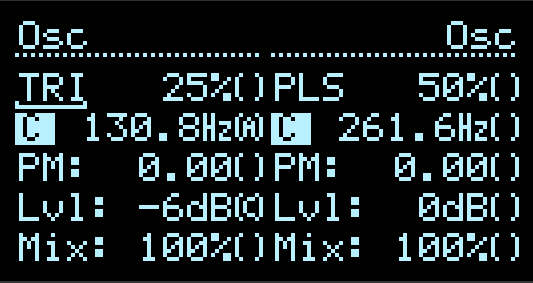Osc (mono)

A basic oscillator voice with built-in waveshaping, FM/PM, VCA, and mixing. Supports a sine, variable slope triangle, and variable pulse width square wave. Processes the output of the preceding applet in the chain by mixing it with the voice and/or by using as a modulation source.
Parameters
- Waveform: Which waveform to use.
- SIN: Sine wave.
- TRI: Variable slope triangle wave.
- PLS: Variable pulse-width square.
- Duty-cycle %: Only active for TRI and PLS waveforms. CVable.
- TRI: Changes the angle of the slopes, ranging from reverse sawtooth at 0%, to triangle at 50%, to sawtooth at 100%.
- PLS: Changes the width of the pulse.
- Frequency: Adjusts the frequency of the wave. CVable using v/oct.
- Note name: Indicates the closest note in a 12-tone chromatic scale (with A4 = 440 Hz). Changing the note name will change the frequency in semitone increments.
- Hz: Allows finer grained adjustments of frequency.
- PM/FM: Phase modulation or frequency modulation. The incoming audio signal will be used as the modulator.
- PM/FM label: Changes whether to use PM or exponential FM. Note that PM with sine modulator and carrier is equivalent to TZFM and will give you classic DX7-like FM.
- Depth:
- For PM: Unit is period of the carrier.
- For FM: Unit is octaves.
- CV: Acts as a linear VCA on the modulator.
- Lvl: The gain applied to the output signal in dBs. CV responds exponentially. If a CV source is present, lvl will be the maximum gain applied.
- Mix: Mixes the incoming signal with the waveform. CVable.
Suggested patches
- Use an AD or ADSR CV applet as a source for lvl to easily create a simple voice with an envelope.
- Stack multiple Osc applets in a chain, and use the Mix parameter to blend them together. Then, tune them in relative harmonics to create chords. Patch the same sequencer source into the v/oct inputs of each so they’ll maintain their harmonic relationships.
- Stack multiple Osc applet together and turn up their PM depth to create chains of FM operators.
- Create even more complex FM topologies by use the Crosspan applet to mix modulator signals together from both channels.
Credits
Authored by qiemem (Bryan Head), with mods by djphazer.